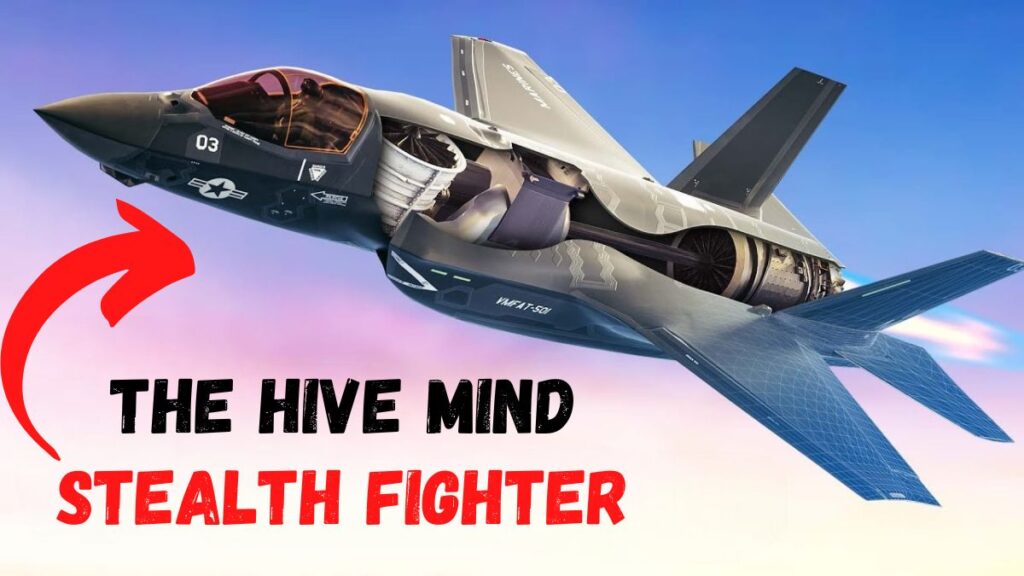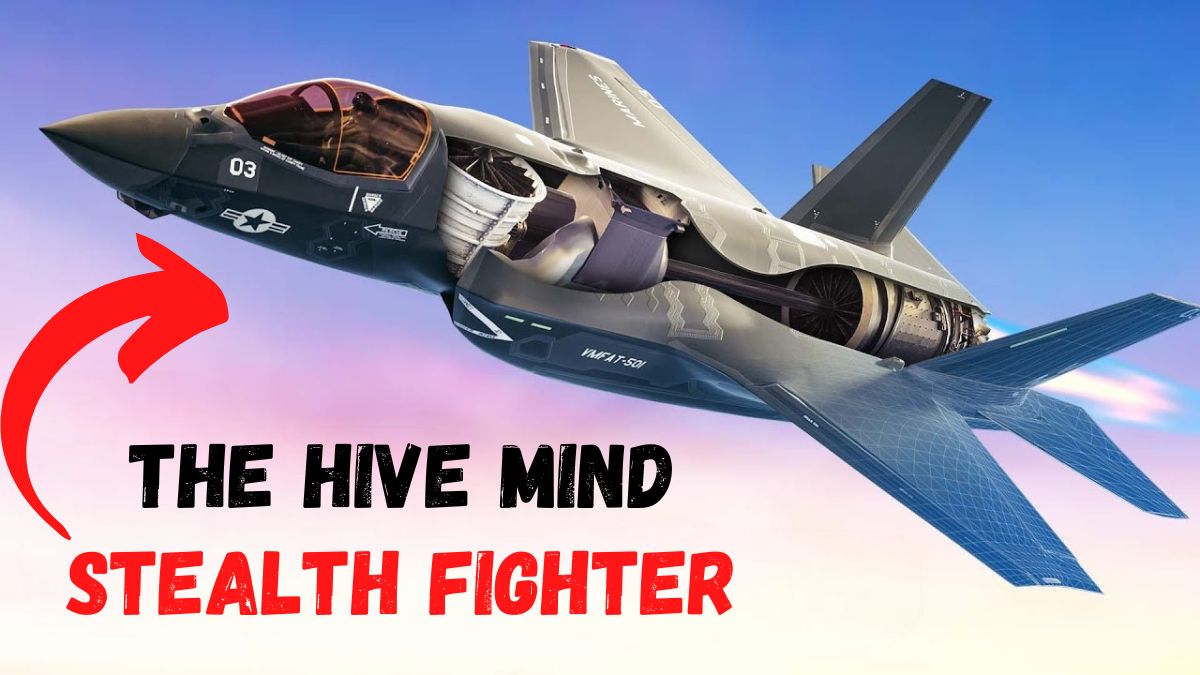
The F-35B is unquestionably the most advanced aircraft ever produced.
a master of none. a stealth fighter plane that combines and enhances the F-16, AV-8B Harrier, and B-2’s capabilities.
a fighter plane with excellent maneuverability that can strike targets on the ground as well as in the air.
A fighter that uses the lessons learned from Lockheed’s previous attempts at stealth, such as the F-117 Nighthawk and F-22 Raptor. a plane with the most cutting-edge computer systems and sensors.
Presenting the information directly on a heads-up display on the pilot’s helmet visor and sharing it almost immediately with allies without sacrificing stealth giving an unparalleled awareness of the situation. allowing a flight of F-35s to fight as a hivemind effectively.
The F-35B can switch from horizontal to vertical flight with a single button press by utilizing directional thrust and a massive vertical turbofan engine that is concealed within the plane’s body. This is perhaps the most daring feature of all.
enabling a helicopter-like landing on the US Marines’ relatively small amphibious assault ships.
It is extremely challenging to integrate all of these capabilities into a single airframe.
The exterior of the plane must be carefully molded in order to design for stealth, dictating the design of important features.
making tradeoffs that can’t be avoided. There are numerous erroneous notions regarding stealth.
The objective is not to conceal an aircraft; it will be detectable; rather, the objective is to delay enemy detection for as long as possible.
It reduces the range of the enemy’s radar stations for bomber aircraft, potentially allowing the aircraft to pass through radar defenses undetected.
It gives fighter aircraft a crucial advantage by allowing them to spot their enemies before they do. We must make it harder for the radar receiver to determine whether the return signal is just background noise or an enemy aircraft in order to gain these advantages.
We must reduce the return signal’s strength in order to accomplish this. A radar wave can be reflected in a variety of ways. Specular return, also known as regular reflection, is the most significant and obvious method, similar to a mirror.
- 1. where the incidence angle is the same as the angle of reflection.
- 2. The diverterless supersonic inlet, or DSI, was put to the test in later F-16 variants.
- 3. The F-35's critical components were concealed by these serrated hatches, but more can be done to reduce edge scattering in these locations.
- 4. By rotating each of these angled pieces independently, we can alter the nozzle's shape.
- EXPLORE More:
1. where the incidence angle is the same as the angle of reflection.
We want to stay away from big, flat surfaces that could reflect back to the radar receiver right away.
Corner reflectors, in which two surfaces are positioned at an angle of 90 degrees to one another, should be avoided at all costs.
A corner reflector can be easily constructed on the vertical and horizontal stabilizer surfaces of tailplanes.
allowing radar to bounce off both surfaces and immediately return to its original path.
The best way to avoid this is to completely remove the tail, like the B-2, but doing so significantly reduces maneuverability.
Instead, we can use a v-tail, like the one on the F-117 Nighthawk, to replace both the horizontal and vertical stabilizers.
By observing the force produced when the control surfaces are moved into various positions, we can see that the v-tail can serve as both an elevator and a rudder.
They can be actuated in opposite directions to produce a horizontal force that provides the same yaw control as a vertical rudder.
Alternatively, we can provide pitch control by deflecting them in the same direction, just like a horizontal elevator would.
The Cirrus SF50, an aircraft with a distinctive appearance, can use this configuration to mount a single, small jet engine on top of the fuselage and direct its exhaust straight through the v-tail.
a private jet that can deploy a parachute to rescue itself in an emergency and is so small and light
It’s not ideal to link the elevator and rudder controls into a single mechanism.
Control surface area is a factor in the need for superior control authority on fighter jets like the F-35 and F-22.
The pitch control gets bigger the bigger the elevator.
The control authority is reduced when a control surface is performing a double role, requiring simultaneous rudder and elevator action.
As a result, both planes have substantial elevators that are angled and offset to prevent corner reflections.
Comparing the F-117 and F-35’s efforts to meet both fighter and stealth requirements reveals numerous design compromises.
Air intakes for the engines of the F-117 and B-2 are mounted on the plane’s upper surface. This prevents ground-based radar from bouncing back to the receiver from inside the intake and helps reduce infrared heat signatures.
However, this is not a design that you would want to include in a plane that is expected to perform high angle of attack maneuvers in life-or-death situations. While performing a maneuver like this, the air intake will receive lower pressure air, which will lower performance right when performance is most needed.
Twin intakes on either side of the fuselage are chosen rather than air intakes located underneath the aircraft, as the F-16’s will result in excessive radar return.
There are also some clever aerodynamic features on the air intake.
A significant role is played by this seemingly insignificant bump.
This is the essence of aeronautical engineering: even seemingly insignificant design details serve a purpose.
Pylon-mounted engines avoid some of the problems that arise when engine intakes are positioned along an aircraft’s body.
A layer of slow-moving turbulent air known as a boundary layer begins to form as air travels the length of the body.
In addition to lowering performance, allowing this air into the engine can cause damage.
On one side, the turbine will rotate through slow boundary air and on the other, through fast free stream air.
As a result, the turbine blade experiences cyclical bending as the force exerted on it changes with each rotation.
a recipe for failure due to fatigue.
A boundary layer diverter separates the inlet from the fuselage with a small gap in planes like the F-16, but this design increases radar cross-section and drag.
2. The diverterless supersonic inlet, or DSI, was put to the test in later F-16 variants.
essentially a massive bump that creates a compression zone that pushes the boundary layer away from the inlet, scatters incoming radar, and reduces drag at the same time.
Its introduction to the F-35 was heralded by the test flight, which demonstrated that it could meet performance requirements.
Weight is reduced by 30%, and production and upkeep costs are reduced.
We can observe additional hints of stealth design as we move down the plane.
Stealth is hindered by long, sharp edges.
Radar waves can travel along a surface as a traveling wave and then scatter when they reach the trailing edge due to sharp edges scattering the waves in all directions.
Using a few clever strategies, you can weaken that return signal.
The first method is to reduce the length of the edge with serration because the strength of the signal will be determined by its length.
On the B-2’s trailing edges, you can clearly see this method.
However, until you start looking at all of the access hatches that are hidden around the F-35, where every unavoidable surface gap has a serrated edge, it is less obvious where it is used.
A telescoping ladder that pilots can use to climb into and out of the aircraft is visible when this hatch opens.
The landing gear is revealed when these open.
These are the smaller hatches that serve as doors for the flare dispenser. These are the internal weapons bays, which are necessary to conceal the radar-reflecting missiles.
Despite their effectiveness as decoys for heat-seeking missiles, flares cannot stop radar-guided missiles.
A new decoy system was developed in response to the proliferation of radar-guided missiles and the continued advancement of technology’s sophistication.
From this panel, this brand-new technology is released.
A transmitter begins to reel out safely behind the plane when this access door is opened.
The F-35 is protected from attack thanks to its three levels of countermeasures.
First, by emitting jamming signals that are calculated by the onboard computer and sent to the emitter via the fiber optic tow line, it actively blocks missiles as they attempt to lock onto their target.
Once the radar has gained access to a lock, it will attempt to break it.
causing disruption to the algorithms that track the missile and direct it toward its target.
Finally, the emitter begins to mimic the aircraft’s radar signature, attracting the missile toward it as a decoy if all else fails and the missile approaches the aircraft.
3. The F-35’s critical components were concealed by these serrated hatches, but more can be done to reduce edge scattering in these locations.
You might notice that these edges are colored differently than the rest of the plane.
This is because a special radar scattering tape is applied to the edges.
When traveling over a change in conductivity, traveling waves will scatter in the same way that they scatter when they come into contact with an edge discontinuity.
The F-35 makes use of this to spread out the waves over a greater distance, thereby reducing the return signal.
Since the tape has a conductivity gradient, its electrical conductivity gradually decreases, scattering radar waves at every interval.
reducing the surface wave’s intensity gradually before it reaches the point where, absent the tape, it would have released a large return.
Specialized radar-absorbing material covers the plane’s surface.
This patent was filed in 2010 by Lockheed Martin for a composite material infused with carbon nanotubes that can absorb radar waves from 0.1 megahertz to 60 gigahertz.
This includes the frequencies that Russian surface-to-air missiles like the advanced S-400 system use, which make up an extremely broad spectrum.
You can see elsewhere how stealth design is influenced by traveling surface waves.
If a radar wave comes in tangentially to a cylinder and the wavelength is at least one tenth of the cylinder’s circumference, the wave can actually travel around the outside of the cylinder and return directly to the receiver, contrary to popular belief.
The F-35 probably has this sharp edge that separates the circular nose cone from the plane.
The F-35 has a ridge instead of the nearly perfect circular nose cone of the F-16.
There is a good reason why the largest hatch on the plane does not have any serrations, which is odd.
The substantial lift fan is concealed within this hatch.
This lift fan’s airflow inside and out required careful consideration.
The lift fan is essentially a small helicopter that can produce 85 kN of vertical thrust. By creating a lower pressure zone above the aircraft and violently sucking air into it at an angle of 90 degrees, it propels the aircraft forward.
This air must pass through the hood in order to reach the inlet; consequently, the hood must permit a smooth flow of air without producing excessive turbulent flow, which would decrease the lift fan’s performance.
Because the sharp edges would distort the flow, the inlet door does not have a serrated design.
In order to improve the flow of air through the hood, multiple design iterations were performed on its own. The final X-35 was equipped with a rear hinged door instead of the two doors that opened to the side on the demonstration aircraft.
When the F-35B does not take off vertically but instead uses the lift fan and the directional thrust of the rear nozzle to take off on extremely short runways, this aids in the funneling of air into the engine and enhances pressure recovery.
It is amazing how quickly this aircraft changes to perform short takeoffs and vertical landings.
It is the closest thing we have ever made to a transformer.
A clutch that connects the extended driveshaft of the F-35 engine will begin to transfer 29,000 horsepower to the lift fan’s bevel-gear when the time is right.
While the contra-rotating lift fan is spinning, gears in the rear exhaust nozzle begin to rotate simultaneously.
The three bearing swivel nozzle’s internal workings are another sight to behold.
It is made up of three airtight sections that have been cut at an angle to one another.
4. By rotating each of these angled pieces independently, we can alter the nozzle’s shape.
To smoothly transition from thrust downwards, these three parts rotate together, but it’s easier to see how it works when we rotate each segment separately.
The nozzle can be turned from zero degrees to 45 degrees by turning the central piece.
When performing short take-offs, this position divides the engine’s power between thrust and lift.
Vertical takeoffs pale in comparison to this mode’s impressiveness.
granting the plane permission to operate from shorter amphibious assault ships like the 258-meter-long USS Makin Island.
With the assistance of a ski-jump, its minimum take-off distance decreases even further.
a ramp that smaller amphibious assault ships now have.
It’s amazing to watch the F-35 take off over such a small distance.
In order to ensure a safe takeoff, the rear nozzle quickly adjusts its angle of thrust in sync with the rear elevators, as shown in this clip.
The final nozzle segment can rotate to provide a full 90-degree turn for a vertical landing.
The first segment of the nozzle can rotate to move the nozzle side to side, but it is necessary here to prevent the thrust from moving side to side as the nozzle changes directions.
As can be seen, each segment moves in an arc when rotated individually, causing the F-35 to spin out of control.
The F-35 is also able to seamlessly switch from cruise to vertical flight and back again when necessary thanks to this mechanism.
This precarious balancing act can be kept in check with additional control mechanisms.
Two roll nozzles on each wing are siphoned with bleed air from the bypass of the main engine.
controlling roll by applying thrust far from the plane’s center of pressure.
Additionally, there are guide vanes beneath the lift fan.
This can control the thrust of the lift fan from 5 degrees forward to 42 degrees backward, as well as adjust the outlet area to alter the liftvan’s performance.
When compared to its predecessor, the AV-8B Harrier, the F-35 is remarkably stable thanks to computer-aided control of these control mechanisms.
allowing the F-35’s single engine to hover over two air columns.
The F-35’s engine, the F-135, which was derived from the F-22 raptor’s F-119 engine, needed to be extremely powerful in order to accomplish this.
The fighter F-22 raptor has two engines.
giving it a lot of extra power to perform amazing maneuvers
To perform a vertical landing, the F-35 has only one engine and must use all of its power.
The F-35s’ engines can produce 191 kilonewtons of thrust, compared to 156 kilonewtons for the F-22.
The engine of the F-35 has twice the bypass ratio of the F-22 because it has a fan and bypass ducting that are much larger.
supplying the F-35 with a cruise engine that is more energy efficient and has a much higher mass flow rate for increased thrust.
However, there are some drawbacks to this.
The acceleration generated in the combustion chamber is lost to the air traveling around the engine core, which completely avoids it.
lowering the speed of the exhaust.
The plane’s maximum speed is lowered as a result.
While the F-22 is the first aircraft to be capable of vertical flight and supersonic flight, the F-35 has a maximum speed of 1.6 mach.
The speed of the F-35 was not the primary focus of its design.
However, that ideology is seriously hindered by the excessive weight required for vertical takeoff.
The lift fan module has a weight of 1.2 tonnes, which means it doesn’t do anything in normal flight and needs more fuel to carry. To make matters worse, space is used for an internal fuel tank in each of its variants.
The F-35B’s battlefield viability depended on making the lift fan as light as possible.
It is amazing that it only weighs 1.2 tonnes and also has two titanium blisks that turn in opposite directions.
Blisk means that the disk and blades are all one piece, as opposed to the traditional method of making a disk and connecting the blades with dovetail connections.
This makes the connection more effective and eliminates a potential point of failure.
The first stage fan takes this incredible manufacturing feat to the next level.
To reduce weight, the blades of the first stage are hollow.
The F-35B’s modern suite of sensors and computers, which all feed into this, is where it really shines.
The integrated heads-up display into the pilot’s helmet.
A panel in the cockpit houses conventional heads-up displays, like those on the F-16.
a panel that the pilot can’t see when they’re looking around.
In the heat of battle, situational awareness is everything, and this helmet does everything it can to keep the pilot informed.
even providing them with night and x-ray vision.
A projector in the helmet processes and displays data obtained from a collection of sensors located all around the aircraft and feed it into a central computer.
A collection of sensors are housed within this transparent, faceted box beneath the aircraft.
These windows are not typical.
Sapphire, a gemstone that is well-known for its high price, is used to make these windows.
one of the few materials that is transparent to a wide range of electromagnetic wavelengths and both durable and hard.
From ultraviolet light to infrared light.
However, the most significant component of this electronic system is the radar antenna that is concealed within the F-35’s nose.
In contrast to conventional mechanical radar, this is a scanned array radar.
There are hundreds of tiny antennas in phased array antennas.
The F-35 phase array antenna’s rows of metal plates are visible to us.
An antenna can be found in each and every one of the slots cut into the metal plates.
1600 altogether.
The phase array antenna can now use both constructive and destructive interference to direct its radar.
Positive interference will increase the radio wave’s amplitude if two antennas release two radar waves simultaneously with their peaks and troughs aligned.
On the other hand, the wave will be completely canceled out if the radio waves are set 180 degrees out of phase and match the peak to the trough.
Earphones that block out noise function in this manner.
In order to create silence, they listen to the background noise and then release a sound wave that cancels it out.
This phenomenon is used by the phased array antenna to direct the radio waves, preventing the radar from becoming a huge beacon that draws enemies right to it.
Phase array antennas of the past are passive.
That is, a single transmitter and receiver drives each antenna in the array.
Because of this, it would only be able to point in one direction, and the passive phase array antenna would no longer be able to track two hostile aircraft flying side by side if they split up.
The F-35’s phase antenna, on the other hand, is an active phased array, which means that each of these antennas is its own independent transmitter and receiver.
Consequently, the F-35 has no moving parts and can simultaneously track multiple targets.
Because these antennas must be visible to radar waves, the nose cones that cover them are typically made of glass fiber composites.
Because a transparent antenna will reflect signals, it affects the plane’s radar return signature in a negative way.
For mechanical radar dishes that needed to point at the enemy to keep track of them, this was a much bigger problem.
The phased array is pointing skyward because it can point at multiple targets while remaining stationary.
to redirect radar into space.
The F-35’s battle doctrine relies heavily on the phased array antenna’s role as the plane’s communication antenna.
The F-35’s networking capabilities make it a formidable weapon on the battlefield.
Relaying information among its squadron This requires a high data transfer speed because it involves transferring a significant amount of data between aircraft and surface allies.
However, there is one major drawback to communication.
It lets anyone who is listening know you are there.
The active phase array antenna makes it possible for stealth planes to securely communicate with one another, which is crucial.
The F-35 makes use of the most recent data link system, MADL, which builds on the lessons learned from the F-22.
allowing the F-35 to securely and quickly exchange data with other F-35s and ground-based systems.
The pilot is then shown this sorted information on a heads-up display right in front of their eyes.
giving them an unparalleled awareness of the situation.
If there is an adversary beneath them, there is no need for pilots to communicate with their wingmates because the planes communicate and feed that information directly into the helmet, allowing the pilot to look underneath the plane and see where the adversary is themselves.
The F-35B is a networked hivemind stealth fighter that can take off from a ship that is only a fraction of the size of an aircraft carrier, return while hovering in the sky like a helicopter, and this is its true strength.
One of the most extraordinary pieces of military technology ever made.
The F-35 has learned a lot from planes like the F-117 Nighthawk and B-2. We haven’t done any documentaries about these planes yet, but our friends at Mustard have done one. Their B-2 documentary is 20 minutes long and features stylish 3D renders.






![Moon Jellyfish has [ Hidden Secrets ] You don't know moon jellyfish](https://spaceupper.com/wp-content/uploads/2022/11/1-1.jpg)
